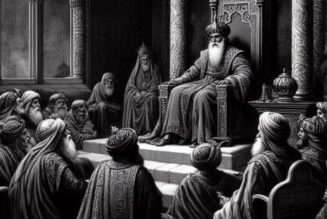By Clement Harrold

If anything can rightly be said about St. Mary Magdalene, it is that she remains a mysterious and oftentimes elusive figure. Over the centuries, her identity has been debated and disputed endlessly, with the result that today many Catholics are left feeling very confused. What exactly do we know about her on the basis of the Gospels? And was she a reformed prostitute?
Thus we know that Mary Magdalene had seven demons cast out of her (see Mk 16:9; Lk 8:2); she helped to fund Jesus’s ministry (see Lk 8:2); she remained with Him at the foot of the cross (see Mt 27:56; Mk 15:40; Lk 23:49; Jn 19:25); and was the first person He publicly appeared to following His Resurrection (see Jn 20:11-18). For the Eastern Fathers, this is all that we can know about Mary Magdalene.
In the West, a rather different understanding of the Magdalene began to emerge in the earliest days of the Church. Beginning with figures like Tertullian (c. 155 – 220) and gaining traction under St. Augustine (354 – 430), a near-unanimous consensus arose in Western Christianity which continued largely unchallenged right up until the twentieth century.
According to this Western perspective, “Magdalene” is simply another title for Mary the sister of Martha and Lazarus, whom today we tend to call Mary of Bethany. Strikingly, this Magdalene figure was also understood by the Western Church to be the sinful woman who comes to anoint the feet of the Lord in the seventh chapter of Luke’s Gospel. On this traditional Western Catholic understanding, therefore, three female New Testament characters are identified as one: Mary Magdalene, Mary the sister of Martha and Lazarus, and the anonymous sinful woman from Luke 7.
This may sound like a bold claim, but it was the position adopted by many of the Church’s greatest saints, mystics, and doctors. To name some examples, Gregory the Great, Bede the Venerable, Anselm of Canterbury, Thomas Aquinas, Catherine of Siena, Thomas More, John Fisher, Teresa of Ávila, John of the Cross, Francis de Sales, Mary of Ágreda, Anne Catherine Emmerich, John Henry Newman, Thérèse of Lisieux, and Elizabeth of the Trinity all believed that Mary Magdalene is the same person as Mary the sister of Martha and Lazarus, and the same person as the anonymous sinful woman in Luke 7.
But what, if anything, does this reveal about Mary Magdalene having been a prostitute? After all, the Gospels never explicitly describe her as such. We do know for sure that Jesus cleansed her of seven demons, but there is no way of knowing whether these demons were the result of sexual vice. So where did the prostitute idea originate?
The idea seems to have originated with Pope St. Gregory the Great in a homily he delivered at the Basilica of St. Clement in Rome in the year 591. Gregory shared the Augustinian conviction that Mary Magdalene is the unnamed woman described in the seventh chapter of Luke’s Gospel, and it was the basis of this particular scene that he inferred that she lived a life of prostitution prior to her encounter with Christ.
Gregory’s inference is based on a close reading of the Gospel text. Upon examining the text of Luke 7:36-50, it seems obvious that the woman in question has earned a very bad reputation for herself. She is described as “woman of the city” (v. 37), and the title clearly is not meant as a compliment! Moreover, the acute sense of shock on the part of the crowd would suggest that this was more than just a dishonest businesswoman.
She has all the appearances of a wretched woman of low social standing whose very presence is considered scandalous by the men gathered there. Identifying her as a prostitute makes sense of these details. Additionally, the act of letting down one’s hair in public was extremely socially taboo at that time. This gesture would be more intelligible, however, if the woman operates in an immoral profession and is therefore accustomed to flouting social norms.
On these grounds, it is reasonable to infer that the anonymous sinful woman of Luke 7 may have been a prostitute of some kind. Hence, if one also embraces the traditional Western understanding that this woman is the Magdalene, then one arrives at the conclusion that Mary Magdalene was indeed a former prostitute. (In fact, for many centuries prior to the 1960s, the Gospel reading for St. Mary Magdalene’s feast day was none other than the passage from Luke 7!)
Today scholars continue to debate the identity of Mary Magdalene, and Catholics are not required to adopt any particular view. Yet it is worth recognizing how the vision of Mary Magdalene as a biblical heroine with a scandalous past became enormously popular in the Middle Ages, leading to the widespread exaltation of this beautiful female saint. Indeed, for many believers, the Medieval depiction of Mary Magdalene as sinner-turned-saint offered an extraordinary model of encouragement and inspiration. Here was a woman who had dramatically overcome her vices, offering hope to the most hardened sinner.
Further reading:
Fr. Sean Davidson, Saint Mary Magdalene: Prophetess of Eucharistic Love (Ignatius Press, 2017)
https://churchlifejournal.nd.edu/articles/a-retrieval-of-the-traditional-view-of-mary-magdalene/
Clement Harrold earned his master’s degree in theology from the University of Notre Dame in 2024, and his bachelor’s from Franciscan University of Steubenville in 2021. His writings have appeared in First Things, Church Life Journal, Crisis Magazine, and the Washington Examiner.
You Might Also Like
Dr. Hahn explores the “covenant love” God reveals to us through the Scriptures and explains how God patiently reaches out to us—despite our faults and shortcomings—to restore us into relationship with his divine family. Join Hahn as he follows the high adventure of God’s plan for the ages, beginning with Adam and Eve and continuing down through the generations to the coming of Christ and the birth of the Church. You’ll discover how the patient love of the Father revealed in the Bible is the same persistent love he has for you. A Servant Book.









